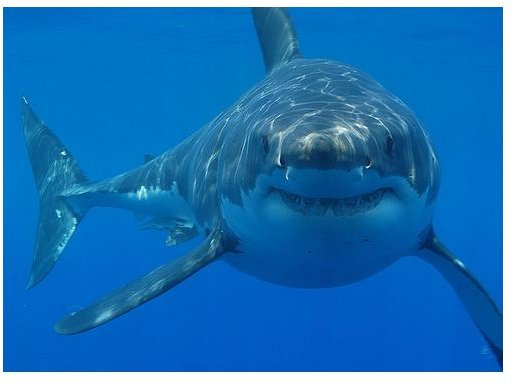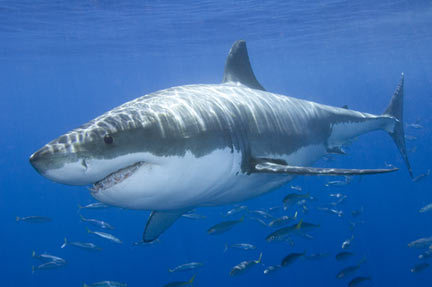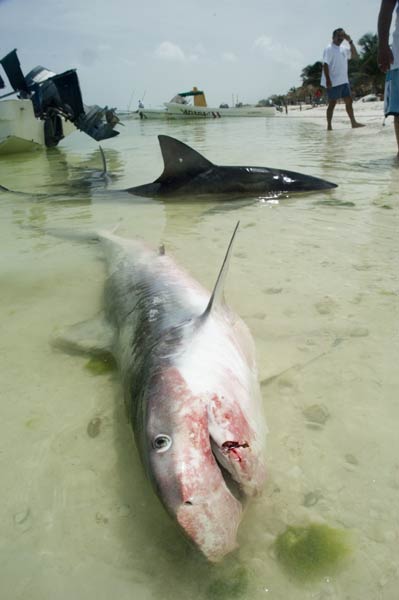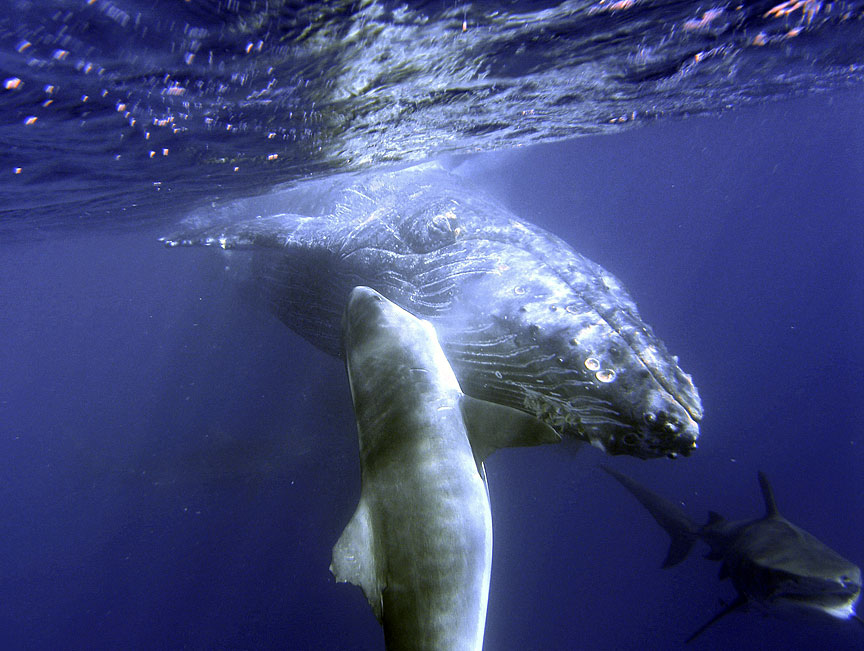Source (google.com.pk)
Great White Shark Vs Tiger Shark Biography
The great white shark, scientific name Carcharodon carcharias, also known as the great white, white pointer, white shark, or white death, is a large lamniform shark found in coastal surface waters in all major oceans. It is known for its size, with the largest individuals known to have approached or exceeded 6 metres (20 ft) in length, and 2,268 kilograms (5,000 lb) in weight. This shark reaches maturity at around 15 years of age and can have a life span of over 30 years. The great white shark is arguably the world's largest known extant macropredatory fish and is one of the primary predators of marine mammals. It is also known to prey upon a variety of other marine animals including fish, pinnipeds, and seabirds. It is the only known surviving species of its genus, Carcharodon, and is ranked first in a list of number of recorded attacks on humans. The IUCN treats the great white shark as vulnerable, while it is included in Appendix II of CITES. Great white sharks live in almost all coastal and offshore waters which have water temperature between 12 and 24 °C (54 and 75 °F), with greater concentrations in the United States (Atlantic Northeast and California), South Africa, Japan, Australia (especially New South Wales and South Australia), New Zealand, Chile, and the Mediterranean. One of the densest known populations is found around Dyer Island, South Africa where much shark research is conducted. It is an epipelagic fish, observed mostly in the presence of rich game like fur seals, sea lions, cetaceans, other sharks, and large bony fish species. In the open ocean it has been recorded at depths as great as 1,220 m (4,000 ft). These findings challenge the traditional notion about the great white as being a coastal species. According to a recent study, California great whites have migrated to an area between Baja California and Hawaii known as White Shark Café to spend at least 100 days before migrating back to Baja. On the journey out, they swim slowly and dive down to around 900 m (3,000 ft). After they arrive, they change behavior and do short dives to about 300 m (1,000 ft) for up to 10 minutes. Another white shark tagged off the South African coast swam to the southern coast of Australia and back within the year. This refuted traditional theories that white sharks are coastal territorial predators and opens up the possibility of interaction between shark populations that were previously thought to be discrete. Why they migrate and what they do at their destination is still unknown. Possibilities include seasonal feeding or mating. The great white shark has a robust large conical snout. The upper and lower lobes on the tail fin are approximately the same size (like some mackerel sharks). Great whites display countershading, having a white underside and a grey dorsal area (sometimes in a brown or blue shade) that gives an overall mottled appearance. The coloration makes it difficult for prey to spot the shark because it breaks up the shark's outline when seen from the side. From above, the darker shade blends with the sea and from below it exposes a minimal silhouette against the sunlight. Great white sharks, like many other sharks, have rows of serrated teeth behind the main ones, ready to replace any that break off. When the shark bites it shakes its head side to side, helping the teeth saw off large chunks of flesh. Males reach maturity at 3.5–4.0 metres (11–13 ft) and females at 4.5–5.0 m (15–16 ft). Adults on average are 4–5.2 m (13–17.1 ft) long and have a mass of 680–1,100 kilograms (1,500–2,400 lb). Females are generally larger than males. It is widely accepted that the great white shark can reach 6.1 m (20 ft) in length and 1,900 kg (4,200 lb) in weight. The maximum size is subject to debate because some reports are rough estimations or speculations performed under questionable circumstances. Great white sharks are carnivorous and prey upon fish (e.g. tuna, rays, other sharks), cetaceans (i.e., dolphins, porpoises, whales), pinnipeds (e.g. seals, fur seals, and sea lions), sea turtles, sea otters, and seabirds. Great whites have also been known to eat objects that they are unable to digest. Although the great white is typically regarded as an apex predator in the wild, it is in rare cases preyed upon by the larger orca (also known as a killer whale).
Tiger Shark - Galeocerdo cuvier
The tiger sharks, Galeocerdo cuvier, is a species of requiem shark and the only member of the genus Galeocerdo. Commonly known as sea tigers, tiger sharks are relatively large macropredators, capable of attaining a length of over 5 m (16 ft). It is found in many tropical and temperate waters, and is especially common around central Pacific islands. Its name derives from the dark stripes down its body which resemble a tiger's pattern and fade as the shark matures. The tiger shark is a solitary, mostly night-time hunter. Its diet involves a wide range of prey, including crustaceans, fish, seals, birds, smaller sharks, squid, turtles, sea snakes, and dolphins. One of the largest sharks living today, the tiger shark commonly attains a length of 3 to 4.2 m (9.8 to 13.8 ft) and weighs around 385–635 kilograms (849–1,400 lb). Sometimes a male tiger shark can grow up to 4.5 meters (14-15 feet long) and females to 5.5 meters (18 feet long). A tiger shark can sometimes rival a great white shark in size. The tiger shark can grow up to 14-20 feet long.


Great White Shark Vs Tiger Shark

Great White Shark Vs Tiger Shark

Great White Shark Vs Tiger Shark

Great White Shark Vs Tiger Shark

Great White Shark Vs Tiger Shark

Great White Shark Vs Tiger Shark

Great White Shark Vs Tiger Shark

Great White Shark Vs Tiger Shark

Great White Shark Vs Tiger Shark
Great White Shark Vs Tiger Shark Biography
The great white shark, scientific name Carcharodon carcharias, also known as the great white, white pointer, white shark, or white death, is a large lamniform shark found in coastal surface waters in all major oceans. It is known for its size, with the largest individuals known to have approached or exceeded 6 metres (20 ft) in length, and 2,268 kilograms (5,000 lb) in weight. This shark reaches maturity at around 15 years of age and can have a life span of over 30 years. The great white shark is arguably the world's largest known extant macropredatory fish and is one of the primary predators of marine mammals. It is also known to prey upon a variety of other marine animals including fish, pinnipeds, and seabirds. It is the only known surviving species of its genus, Carcharodon, and is ranked first in a list of number of recorded attacks on humans. The IUCN treats the great white shark as vulnerable, while it is included in Appendix II of CITES. Great white sharks live in almost all coastal and offshore waters which have water temperature between 12 and 24 °C (54 and 75 °F), with greater concentrations in the United States (Atlantic Northeast and California), South Africa, Japan, Australia (especially New South Wales and South Australia), New Zealand, Chile, and the Mediterranean. One of the densest known populations is found around Dyer Island, South Africa where much shark research is conducted. It is an epipelagic fish, observed mostly in the presence of rich game like fur seals, sea lions, cetaceans, other sharks, and large bony fish species. In the open ocean it has been recorded at depths as great as 1,220 m (4,000 ft). These findings challenge the traditional notion about the great white as being a coastal species. According to a recent study, California great whites have migrated to an area between Baja California and Hawaii known as White Shark Café to spend at least 100 days before migrating back to Baja. On the journey out, they swim slowly and dive down to around 900 m (3,000 ft). After they arrive, they change behavior and do short dives to about 300 m (1,000 ft) for up to 10 minutes. Another white shark tagged off the South African coast swam to the southern coast of Australia and back within the year. This refuted traditional theories that white sharks are coastal territorial predators and opens up the possibility of interaction between shark populations that were previously thought to be discrete. Why they migrate and what they do at their destination is still unknown. Possibilities include seasonal feeding or mating. The great white shark has a robust large conical snout. The upper and lower lobes on the tail fin are approximately the same size (like some mackerel sharks). Great whites display countershading, having a white underside and a grey dorsal area (sometimes in a brown or blue shade) that gives an overall mottled appearance. The coloration makes it difficult for prey to spot the shark because it breaks up the shark's outline when seen from the side. From above, the darker shade blends with the sea and from below it exposes a minimal silhouette against the sunlight. Great white sharks, like many other sharks, have rows of serrated teeth behind the main ones, ready to replace any that break off. When the shark bites it shakes its head side to side, helping the teeth saw off large chunks of flesh. Males reach maturity at 3.5–4.0 metres (11–13 ft) and females at 4.5–5.0 m (15–16 ft). Adults on average are 4–5.2 m (13–17.1 ft) long and have a mass of 680–1,100 kilograms (1,500–2,400 lb). Females are generally larger than males. It is widely accepted that the great white shark can reach 6.1 m (20 ft) in length and 1,900 kg (4,200 lb) in weight. The maximum size is subject to debate because some reports are rough estimations or speculations performed under questionable circumstances. Great white sharks are carnivorous and prey upon fish (e.g. tuna, rays, other sharks), cetaceans (i.e., dolphins, porpoises, whales), pinnipeds (e.g. seals, fur seals, and sea lions), sea turtles, sea otters, and seabirds. Great whites have also been known to eat objects that they are unable to digest. Although the great white is typically regarded as an apex predator in the wild, it is in rare cases preyed upon by the larger orca (also known as a killer whale).
Tiger Shark - Galeocerdo cuvier
The tiger sharks, Galeocerdo cuvier, is a species of requiem shark and the only member of the genus Galeocerdo. Commonly known as sea tigers, tiger sharks are relatively large macropredators, capable of attaining a length of over 5 m (16 ft). It is found in many tropical and temperate waters, and is especially common around central Pacific islands. Its name derives from the dark stripes down its body which resemble a tiger's pattern and fade as the shark matures. The tiger shark is a solitary, mostly night-time hunter. Its diet involves a wide range of prey, including crustaceans, fish, seals, birds, smaller sharks, squid, turtles, sea snakes, and dolphins. One of the largest sharks living today, the tiger shark commonly attains a length of 3 to 4.2 m (9.8 to 13.8 ft) and weighs around 385–635 kilograms (849–1,400 lb). Sometimes a male tiger shark can grow up to 4.5 meters (14-15 feet long) and females to 5.5 meters (18 feet long). A tiger shark can sometimes rival a great white shark in size. The tiger shark can grow up to 14-20 feet long.
Great White Shark Vs Tiger Shark

Great White Shark Vs Tiger Shark

Great White Shark Vs Tiger Shark

Great White Shark Vs Tiger Shark

Great White Shark Vs Tiger Shark

Great White Shark Vs Tiger Shark

Great White Shark Vs Tiger Shark

Great White Shark Vs Tiger Shark

Great White Shark Vs Tiger Shark

Great White Shark Vs Tiger Shark

Great White Shark Vs Tiger Shark
No comments:
Post a Comment